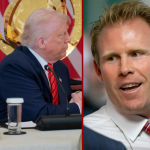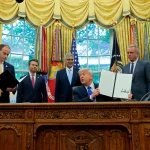3 leftist justices would have let those requiring medical transitions, accommodations to remain in ranks
By Bob Unruh

The U.S. Supreme Court, in a 6-3 ruling, said President Donald Trump’s ban on transgender service members and ideologies in the U.S. military may stand.
Trump, on taking office for his second term, issued that order because transgender warriors require inordinate amounts of medical and other treatments, are not ordinarily ready for deployment and create other issues for fellow soldiers.
The decision Tuesday halted a lower court’s decision that prevented the policy from taking effect.
As expected, the leftist trio of Sonia Sotomayor, Elena Kagan and Ketanji Jackson, who infamously was unable to even define “woman” during her Senate confirmation hearing, would have allowed the lower court order to stand, in a move that would have prevented the president of making the U.S. military better and more formidable.
The lower court judge, Benjamin H. Settle, had claimed, “Because the military has operated smoothly for four years under the (pro-transgender) Austin Policy, any claimed hardship it may face in the meantime pales in comparison to the hardships imposed on transgender service members and otherwise qualified transgender accession candidates, tipping the balance of hardships sharply toward plaintiffs.”
Trump, as commander-in-chief of the U.S. military, had confirmed that “expressing a false ‘gender identity’ divergent from an individual’s sex cannot satisfy the rigorous standards necessary for military service.”
🚨 #BREAKING: The US Supreme Court has SIDED with President Trump and Secretary Hegseth, allowing the transgender military ban to go into effect
LFG! 🔥
Mental illness has NO PLACE in the greatest military on Earth! 🇺🇸 pic.twitter.com/FdC7rEEC6i
— Nick Sortor (@nicksortor) May 6, 2025
Supreme Court allows Trump to enforce his ban on transgender troops serving openly in the military.
The court’s three liberal justices publicly dissent. pic.twitter.com/51dVvMSXYB
— Zach Schonfeld (@ZachASchonfeld) May 6, 2025
Supreme Court rules Trump’s transgender military ban can take effect https://t.co/dE3trKuFZI pic.twitter.com/AKV01iOTCU
— New York Post (@nypost) May 6, 2025
According to a report from CBS, the ban on transgenders will remain in effect “while legal proceedings move forward.”
Trump had determined that the military’s “high standards for troop readiness, lethality, cohesion, honesty, humility, uniformity and integrity” are inconsistent with the “medical, surgical and mental health constraints on individuals with gender dysphoria.”
The president continued, “A man’s assertion that he is a woman, and his requirement that others honor this falsehood, is not consistent with the humility and selflessness required of a service member.”
Trump already, during his first term, had barred transgenders from the U.S. military, a move that the Supreme Court allowed then.
Joe Biden, whose top agenda ideologies during his one term appeared to be abortion for all and transgenderism for all, especially children, reversed Trump’s standards.
Secretary of Defense Pete Hegseth, after Trump’s order, told the Pentagon to pause admissions for people with gender dysphoria histories, and halt the so-called “gender-affirming” care that involves chemicals and/or body mutilating surgeries.
As people who follow the science know, changing from male to female or vice versa doesn’t happen, as being male or female is embedded in the human body down to the DNA level.
The CBS report noted the Pentagon disbursed some $52 million on medical “care” to treat gender dysphoria between 2015 and 2024.
The Supreme Court’s ruling came in a case from Washington state on behalf of “seven transgender service members” and others.
The Department of Justice had explained the decision was not discrimination based on sex, but was based on “medical condition, gender dysphoria,” the report said.
The government has told the high court, “If the separation of powers means anything, the government obviously suffers irreparable harm when an unelected judge usurps the role of the political branches in operating the nation’s armed forces.”










